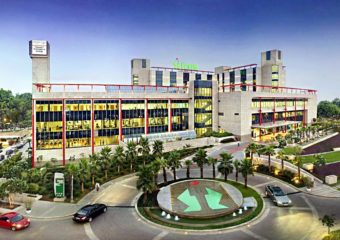Coronary Angioplasty Cost In India
Q. How Much Does Coronary Angioplasty Cost in India?
A. The average cost of coronary angioplasty in India ranges between USD 4000 to USD 4500. depends on your overall health, hospital charges and surgeon experience.

What is Coronary Angioplasty?
Coronary angioplasty (AN-jee-o-plas-tee), also called percutaneous coronary intervention, is a procedure used to open clogged heart arteries. Angioplasty uses a tiny balloon catheter that is inserted in a blocked blood vessel to help widen it and improve blood flow to your heart.
Angioplasty is often combined with the placement of a small wire mesh tube called a stent. The stent helps prop the artery open, decreasing its chance of narrowing again. Most stents are coated with medication to help keep your artery open (drug-eluting stents). Rarely, bare-metal stents may be used.
Angioplasty can improve symptoms of blocked arteries, such as chest pain and shortness of breath. Angioplasty is also often used during a heart attack to quickly open a blocked artery and reduce the amount of damage to your heart.
Who Needs Coronary Angioplasty?
Coronary angioplasty is used to restore blood flow to the heart when the coronary arteries have become narrowed or blocked due to coronary artery disease (CAD).
Angioplasty may be a treatment option for you if:
- You have tried medications or lifestyle changes but these have not improved your heart health.
- You have chest pain (angina) that is worsening.
- You have a heart attack. Angioplasty can quickly open a blocked artery, reducing damage to your heart.
- Angioplasty isn’t for everyone. Depending on the extent of your heart disease and your overall health, your doctor may determine that coronary artery bypass surgery is a better option than angioplasty for you.
You may need coronary artery bypass surgery if:
- The main artery that brings blood to the left side of your heart is narrow
- Your heart muscle is weak
- You have diabetes and multiple severe blockages in your arteries
- In coronary artery bypass surgery, the blocked part of your artery is bypassed using a healthy blood vessel from another part of your body.
Risks of Coronary Angioplasty
As with all types of surgery, coronary angioplasty carries a risk of complications. However, the risk of serious problems is small.
Complications can occur during or after an angioplasty.
The most common angioplasty risks include:
Re-narrowing of your artery. When angioplasty is combined with drug-eluting stent placement, there’s a small risk the treated artery may become clogged again (less than 5%). The risk of re-narrowing of the artery is about 10% to 20% when bare-metal stents are used.
1. Blood clots. Blood clots can form within stents even after the procedure. These clots can close the artery, causing a heart attack. It’s important to take aspirin in combination with clopidogrel (Plavix), prasugrel (Effient) or another medication that helps reduce the risk of blood clots exactly as prescribed to decrease the chance of clots forming in your stent.
Talk to your doctor about how long you’ll need to take these medications. Never discontinue these medications without discussing it with your doctor.
2. Bleeding. You may have bleeding in your leg or arm where a catheter was inserted. Usually this simply results in a bruise, but sometimes serious bleeding occurs and may require a blood transfusion or surgical procedures.
3. Heart attack. Though rare, you may have a heart attack during the procedure.
4. Coronary artery damage. Your coronary artery may be torn or ruptured during the procedure. These complications may require emergency bypass surgery.
5. Kidney problems. The dye used during angioplasty and stent placement can cause kidney damage, especially in people who already have kidney problems. If you’re at increased risk, your doctor may take steps to try to protect your kidneys, such as limiting the amount of contrast dye and making sure that you’re well hydrated during the procedure.
6. Stroke. During angioplasty, a stroke can occur if plaques break loose when the catheters are being threaded through the aorta. Blood clots also can form in catheters and travel to the brain if they break loose. A stroke is an extremely rare complication of coronary angioplasty, and blood thinners are used during the procedure to reduce the risk.
7. Abnormal heart rhythms. During the procedure, the heart may beat too quickly or too slowly. These heart rhythm problems are usually short-lived, but sometimes medications or a temporary pacemaker is needed.
Before Procedure
Before a scheduled angioplasty Surgery, your Surgeon will review your medical history and do a physical exam.
You may need to have some routine tests, including a Blood tests, chest X-ray, electrocardiogram , before your procedure.
Your Surgeon will also perform an imaging test called a coronary angiography to see if the arteries to your heart are blocked and if they can be treated with angioplasty.
If your doctor finds a blockage during your coronary angiogram, it’s possible he or she may decide to perform angioplasty and stenting immediately after the coronary angiography while your heart is still catheterized.
Your doctor will give you instructions to help you prepare.
Your doctor may instruct you to adjust or stop taking certain medications before angioplasty, such as aspirin, nonsteroidal anti-inflammatory drugs (NSAIDs) or blood thinners. Be sure to tell your doctor about all medications you take, including herbal supplements.
Take approved medications with only small sips of water in the morning of your procedure.
Bring your all the medications with you to the hospital.
you’ll be asked to quit smoking before and following the operation.
Ensure that you will not eat and drink from midnight of the day before surgery.
During the procedure
1. An angioplasty normally takes between 30 minutes and two hours, although it can take longer in some cases.
2. At the start of the procedure you’ll be given a local anaesthetic to numb the area in the groin or wrist where a catheter (a fine, flexible, hollow tube) is then passed into an artery.
3. You’ll receive fluids, medications to relax you and blood-thinning medications (anticoagulants) through an IV catheter in your hand or arm.
4. Your heart rate, pulse, blood pressure and oxygen level will be monitored during the procedure.
5. Your doctor will prepare the area in your leg, arm or wrist with an antiseptic solution and will place a sterile sheet over your body.
6. Your Doctor will do a very small cut. A small, thin guidewire is then inserted in the blood vessel.
7. With the help of live X-rays, your doctor will thread a thin tube (catheter) through your artery.
8. Contrast dye is injected through the catheter once it is in place. This allows your doctor to see the inside of your blood vessels and identify the blockage on X-ray images called angiograms.
9. A small balloon with or without a stent at the tip of the catheter is inflated at the site of the blockage, widening the blocked artery. After the artery is stretched, the balloon is deflated and the catheter is removed.
10. If you have several blockages, the procedure may be repeated at each blockage.
11. You might feel pressure in the area where the catheter is inserted. You may also feel some mild discomfort when the balloon is inflated and your artery is stretched, but typically you shouldn’t feel any sharp pain during the procedure.
Coronary Artery Stent
Most people who have an angioplasty also have a stent placed in their blocked artery during the same procedure. A stent is a tiny, expandable metal mesh coil. It is put into the newly opened area of the artery to help keep the artery from narrowing or closing again.
Once the stent has been placed, tissue will start to coat the stent like a layer of skin.
Here’s what happens during a stent placement:
- The stent, which is collapsed around a balloon at the tip of the catheter, is guided through the artery to the blockage.
At the blockage, the balloon is inflated and the spring-like stent expands and locks into place inside the artery.
- The stent stays in the artery permanently to hold it open and improve blood flow to your heart. In some cases, more than one stent may be needed to open a blockage.
- Once the stent is in place, the balloon catheter is deflated and removed.
- More X-ray images (angiograms) are taken to see how well blood flows through your newly widened artery.
- Most stents implanted during an angioplasty are drug coated. The medication in the stent is slowly released to help prevent future plaque buildup and the re-narrowing of the blood vessel.
- After your stent placement, your doctor will prescribe medications, such as aspirin, clopidogrel (Plavix), ticagrelor (Brilinta) or prasugrel (Effient), to reduce the chance of blood clots forming on the stent.
After the Procedure
If you had a nonemergency procedure, you’ll probably remain at the hospital overnight while your heart is monitored and your medications are adjusted. You generally should be able to return to work or your normal routine the week after angioplasty.
When you return home, drink plenty of fluids to help flush your body of the contrast dye. Avoid strenuous exercise and lifting heavy objects for at least a day afterward. Ask your doctor or nurse about other restrictions in activity.
Results
Coronary angioplasty greatly increases blood flow through the previously narrowed or blocked coronary artery. Your chest pain generally should decrease, and you may be better able to exercise.
Having angioplasty and stenting doesn’t mean your heart disease goes away. You’ll need to continue healthy lifestyle habits and take medications as prescribed by your doctor.
If you experience symptoms similar to those you had before your procedure, such as chest pain or shortness of breath, contact your doctor. If you have chest pain at rest or pain that doesn’t respond to nitroglycerin, call 911 or emergency medical help.
To keep your heart healthy after angioplasty, you should:
- Quit smoking
- Lower your cholesterol levels
- Eat a healthy diet that is low in saturated fat
- Maintain a healthy weight
- Control other conditions, such as diabetes and high blood pressure
- Get regular exercise
- Take medications as prescribed by your doctor
- Successful angioplasty also means you might not have to undergo coronary artery bypass surgery, a more invasive procedure that requires longer recovery time
Frequently Asked Questions regarding Balloon Angioplasty
Q. What is angioplasty of the heart?
A. Medically known as percutaneous coronary intervention, angioplasty is a minimally invasive surgical procedure that is performed to remove the obstruction or blockage formed by plaques in the coronary arteries. Angioplasty helps restore the normal blood flow in the body.
Q. How much rest is required after angioplasty?
A. After angioplasty how many days rest should be taken depends on the procedure of angioplasty that was performed. Many patients can return back to normal life within a few days to a maximum of a week after the procedure was performed.
Q. What is double vessel coronary artery disease?
A. A type of coronary disorder, in this case, it means that two important arteries near the heart have simultaneous formations of plaques that are restricting the blood flow. For this condition, angioplasty is not performed and doctors advise the more invasive coronary bypass surgery.
Q. Do stents have to be replaced after they have been placed in the coronary artery?
A. Stents made of metal can last for a lifetime as normal tissues start to form after the stent is placed inside the artery. Stents do not essentially need to be replaced but if scar tissue formations and blood clots are seen occurring in the area then it can be risky for the patient and they may suffer a heart attack.
Q. Can stents be removed after angioplasty?
A. In some cases, if the stents close then the doctors can perform procedures to reopen the stent or even add new stents in the area. But heart stent removal is not an option as normal body tissue starts to form in and around the stent after it is placed in the artery.
Q. What is the cost of angioplasty in India?
A. Angioplasty surgery costs anywhere between one to three lakhs rupees in India and it varies from one hospital to another.
Q. What is PTCA?
A. Percutaneous transluminal coronary angioplasty or PTCA is an alternative name for percutaneous coronary intervention or PCI.
Q. What is the success rate of angioplasty surgery?
A. The success rate of the angioplasty procedure is exceptional. In most patients, angioplasty is successful in opening blocked blood vessels near the heart in over 90 percent of the patients. About 30 to 40 percent of such patients tend to develop re-narrowing of the blood vessel at the site of balloon inflation.
Q. Are there any serious complications with angioplasty?
A. Just like any other major surgery, coronary angioplasty tends to carry some risk of complications. But, the risk is very minimal. This is because the complications can take place during or after the angioplasty. It’s quite common to experience bleeding or bruising under the skin, especially where the catheter was inserted.
Q. What is the difference between angioplasty and a stent?
A. An angioplasty is a process that opens narrow or blocked blood vessels that supply blood to the heart, also known as coronary arteries. The coronary artery stent is a small, metal mesh tube that expands inside the coronary artery. The stent is often placed immediately after or during an angioplasty.
Q. What are the warning signs of clogged arteries?
A. The symptoms of clogged arteries include-
- Chest pain
- Trouble breathing or shortness of breath
- Heart palpitations
- Dizziness and fatigue
- Nausea
- Intense sweating
Q. What does a blocked artery feel like?
A. If a coronary artery is completely blocked then it will cause a heart attack. The classic signs of a blocked artery include a crushing pressure within your chest and shooting pain in your left shoulder and arm, it also includes shortness of breath and sweating. Sometimes a heart attack can occur without any glaring signs or symptoms.
Q. Which is safer, bypass or angioplasty surgery?
A. Since the bypass is a more invasive procedure, it is generally recommended only for patients with a high risk of more than two narrow or blocked arteries. Angioplasty is recommended to patients who are at low risk of a heart attack but have one or two narrow arteries.
Q. How can you stay fit after getting an angioplasty?
A. Once you recover from your angioplasty surgery, the doctor will recommend that you start taking on more heart-healthy habits. Doctors usually tell their patients to have a healthy, nutritious diet that includes no smoking and limiting alcohol. It also includes plenty of exercise like cardiac rehabilitation.
While you may not indulge in high-intensity exercises, you can perform light exercises like going for walks. Exercising is crucial if you want to improve your long term health. Your doctor might even refer you to a cardiac rehabilitation center which will help you set a healthy eating lifestyle; a rehab is important if you need counselling post-surgery, and if you want to quit smoking.
Q. What are the benefits of angioplasty?
When you treat narrow or blocked arteries with angioplasty and stents, you gain the following benefits:
- Increase your life span and reduce any damage to the heart muscles, which can occur during a heart attack, by restoring blood flow to the heart.
- It can relieve any heart disease symptoms like chest pains, shortness of breath, and lethargy. It also makes you feel energetic and active, everyday
- Reduces the risk of stroke in the future
- Improves kidney functions
- Restores blood flow to the legs, this helps prevent gangrene and removes the need for amputation.






